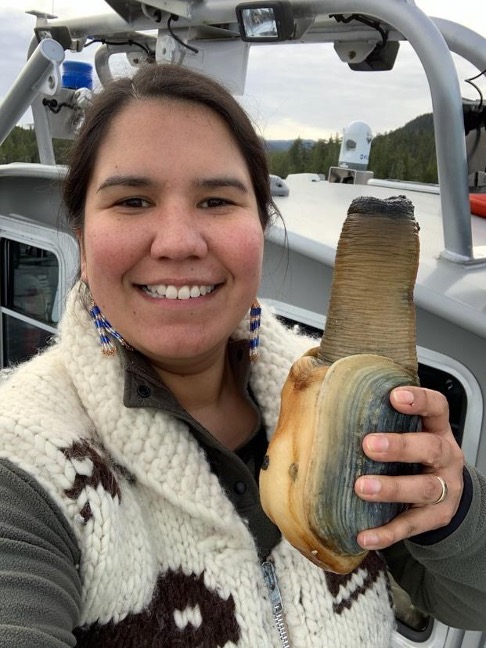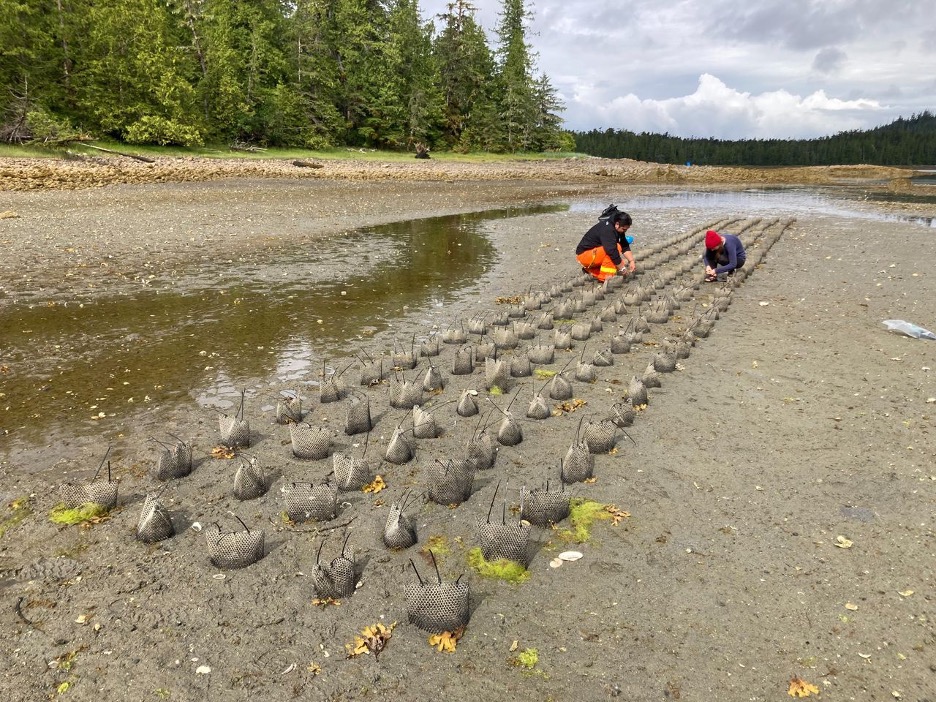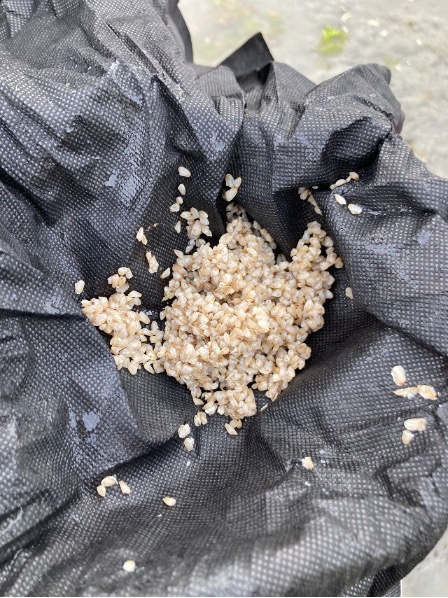
Desiree Lawson, former MaPP Implementation Coordinator for the Central Coast Indigenous Resource Alliance (CCIRA), shows off a robust geoduck harvested near her home in Bella Bella, Haíɫzaqv (Heiltsuk) territory. “The first time I saw one, I was impressed with how heavy and massive it was, and I imagined how many people one geoduck could feed,” she said
A research partnership is helping Central Coast First Nations get the data they need to evaluate opportunities in the vibrant international seafood market for Panopea generosa — or geoduck, as this species of burrowing clam is more commonly known.
A traditional food for coastal Indigenous people, geoduck can live more than 140 years, and a single female geoduck can produce 5 billion eggs over the course of her life. The clams are described as having a sweet, clean ocean taste and a texture that’s squid-like with a bit of crunch. Since the 1970s, B.C.’s geoduck industry has grown into a multi-million-dollar business. Today, about 3 million pounds are harvested annually by divers in waters up to 30 metres deep, and by people digging them up at low tide. More than 90 percent of this harvest is flown fresh to Asia, where it can fetch $30 a pound.
For First Nations that are part of the Marine Plan Partnership (MaPP), the burning question is whether geoduck clams can be profitably cultivated to become a sustainable business.
“It is a very hot commodity right now, and there is a lot of interest in cultivating [geoduck] in both subtidal and intertidal zones,” observes Dr. Myron Roth, an aquaculture and marine fisheries expert at the Ministry of Agriculture & Food. “But we don’t really have the numbers yet to show how lucrative it will be. On paper it looks really good, but nobody grows fish on paper!”
“This industry is very much in its infancy,” adds Sally Cargill, a marine planning specialist at the Ministry of Water, Land and Resource Stewardship, and the provincial co-lead for MaPP implementation. “There’s quite a bit of investment required up front to start a commercial operation, so the feasibility of it needs to be looked at very closely.”
That’s why Central Coast MaPP partners, the Heiltsuk and Kitasoo Xai’xais Nations, have teamed up with North Island College (NIC) on a five-year research project to explore the viability of intertidal geoduck aquaculture in the region. During the summer of 2023, juvenile geoduck were planted at study sites on the Central Coast, selected based on the Nations’ knowledge of geoduck in the area, key habitat parameters, and other factors. “You need that ‘Goldilocks zone’,” explains Logan Zeinert, a research technician from NIC’s Centre for Applied Research, Technology & Innovation and Project Lead. “A good sandy site with a deep enough substrate that the geoduck clams can bury themselves.” Over the next two years, geoduck survival and growth at these sites will be carefully monitored and compared to determine optimal production conditions. The resulting data will be useful both to researchers and the communities evaluating the commercial viability of geoduck aquaculture at these sites.

Out-planting geoduck seeds at low tide at one of four study sites on the Central Coast. The seeds are planted in Vexar mesh tubes to protect them from predation. Photo: Logan Zeinert.
“I hope geoduck aquaculture can deliver financial benefits and employment for our Nations,” says Heiltsuk Nation Aquatics Manager Mike Reid from his home in Bella Bella. “The bigger point is that it could provide more sustainable, low-impact food source, especially as other sources, like salmon, are not doing well.” Reid says the Heiltsuk and other coastal peoples have long harvested geoduck for food, even in subtidal zones, using ingenious methods that predated technologies used by today’s underwater harvesters.
Santana Edgar, Marine Planning Coordinator for the Kitasoo Xai’xais, is also looking forward to research insights. “Can we successfully grow geoduck, and do we have enough suitable intertidal habitat to achieve the economies of scale to create meaningful employment for our people?” she asks. “Kitasoo Xai’xais have been engaged in finfish aquaculture since the 1990s and have always wanted to expand operations into shellfish aquaculture. This can be a low impact way of benefiting from our surrounding ocean.”

In the right conditions, baby geoduck clams like these can grow to a harvestable size of a few pounds each within six to ten years—but they can live more than 140 years. Photos: Logan Zeinert (left) and Geneviève Reynolds (right).
Core funding for the project comes from the Natural Sciences and Engineering Research Council of Canada (NSERC), and the Rural Economic Diversification and Infrastructure Program (REDIP), with additional funds and in-kind contributions from CCIRA, the Central Coast Commercial Fisheries Association (CCCFA), the Province of B.C, and Fisheries and Oceans Canada (DFO).



